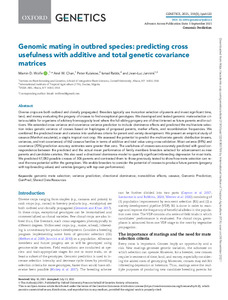| dc.contributor.author | Wolfe, M. |
| dc.contributor.author | Chan, A.W. |
| dc.contributor.author | Kulakow, P. |
| dc.contributor.author | Rabbi, I.Y. |
| dc.contributor.author | Jannink, J. |
| dc.date.accessioned | 2022-02-04T13:54:11Z |
| dc.date.available | 2022-02-04T13:54:11Z |
| dc.date.issued | 2021 |
| dc.identifier.citation | Wolfe, M., Chan, A.W., Kulakow, P., Rabbi, I.Y. & Jannink, J. (2021). Genomic mating in outbred species: predicting cross usefulness with additive and total genetic covariance matrices. Genetics, 219(3), 1-14. |
| dc.identifier.issn | 0016-6731 |
| dc.identifier.uri | https://hdl.handle.net/20.500.12478/7350 |
| dc.description.abstract | Diverse crops are both outbred and clonally propagated. Breeders typically use truncation selection of parents and invest significant time, land, and money evaluating the progeny of crosses to find exceptional genotypes. We developed and tested genomic mate selection criteria suitable for organisms of arbitrary homozygosity level where the full-sibling progeny are of direct interest as future parents and/or cultivars. We extended cross variance and covariance variance prediction to include dominance effects and predicted the multivariate selection index genetic variance of crosses based on haplotypes of proposed parents, marker effects, and recombination frequencies. We combined the predicted mean and variance into usefulness criteria for parent and variety development. We present an empirical study of cassava (Manihot esculenta), a staple tropical root crop. We assessed the potential to predict the multivariate genetic distribution (means, variances, and trait covariances) of 462 cassava families in terms of additive and total value using cross-validation. Most variance (89%) and covariance (70%) prediction accuracy estimates were greater than zero. The usefulness of crosses was accurately predicted with good correspondence between the predicted and the actual mean performance of family members breeders selected for advancement as new parents and candidate varieties. We also used a directional dominance model to quantify significant inbreeding depression for most traits. We predicted 47,083 possible crosses of 306 parents and contrasted them to those previously tested to show how mate selection can reveal the new potential within the germplasm. We enable breeders to consider the potential of crosses to produce future parents (progeny with top breeding values) and varieties (progeny with top own performance). |
| dc.description.sponsorship | UK’s Foreign, Commonwealth & Development Office |
| dc.description.sponsorship | Bill & Melinda Gates Foundation |
| dc.format.extent | 1-14 |
| dc.language.iso | en |
| dc.subject | Genomics |
| dc.subject | Marker-Assisted Selection |
| dc.subject | Cassava |
| dc.subject | Forecasting |
| dc.subject | Genetic Covariance |
| dc.title | Genomic mating in outbred species: predicting cross usefulness with additive and total genetic covariance matrices |
| dc.type | Journal Article |
| cg.contributor.crp | Roots, Tubers and Bananas |
| cg.contributor.affiliation | Cornell University |
| cg.contributor.affiliation | International Institute of Tropical Agriculture |
| cg.contributor.affiliation | United States Department of Agriculture |
| cg.coverage.region | Africa |
| cg.coverage.region | West Africa |
| cg.coverage.country | Nigeria |
| cg.coverage.hub | Headquarters and Western Africa Hub |
| cg.researchtheme | Biotech and Plant Breeding |
| cg.identifier.bibtexciteid | WOLFE:2021 |
| cg.isijournal | ISI Journal |
| cg.authorship.types | CGIAR and advanced research institute |
| cg.iitasubject | Agronomy |
| cg.iitasubject | Cassava |
| cg.iitasubject | Food Security |
| cg.iitasubject | Plant Breeding |
| cg.iitasubject | Plant Production |
| cg.journal | Genetics |
| cg.notes | Open Access Article; Published online: 03 Sep 2021 |
| cg.accessibilitystatus | Open Access |
| cg.reviewstatus | Peer Review |
| cg.usagerightslicense | Creative Commons Attribution 4.0 (CC BY 0.0) |
| cg.targetaudience | Scientists |
| cg.identifier.doi | https://dx.doi.org/10.1093/genetics/iyab122 |
| cg.iitaauthor.identifier | Peter Kulakow: 0000-0002-7574-2645 |
| cg.iitaauthor.identifier | Ismail Rabbi: 0000-0001-9966-2941 |
| cg.futureupdate.required | No |
| cg.identifier.issue | 3 |
| cg.identifier.volume | 219 |

